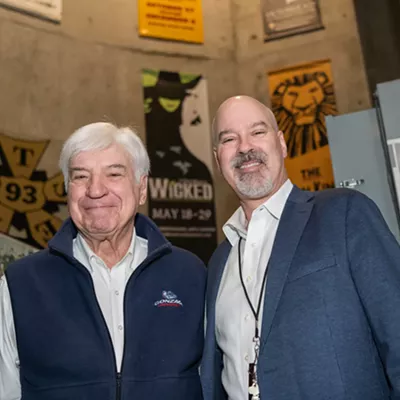Big Bonuses
[
{
"name": "Broadstreet - Instory",
"component": "25846487",
"insertPoint": "4",
"requiredCountToDisplay": "4"
},{
"name": "Broadstreet - Empower Local",
"component": "27852456",
"insertPoint": "8",
"requiredCountToDisplay": "8"
},{
"name": "Broadstreet - Instory",
"component": "25846487",
"insertPoint": "12",
"requiredCountToDisplay": "12"
},{
"name": "Broadstreet - Instory - 728x90 / 970x250",
"component": "27852677",
"insertPoint": "18",
"requiredCountToDisplay": "18"
},{
"name": "Broadstreet - Instory",
"component": "25846487",
"insertPoint": "5th",
"startingPoint": "23",
"requiredCountToDisplay": "24",
"maxInsertions": 100
}
]
by Ted S. McGregor, Jr.
A line near the end of a May 1 New York Times story about the West's electricity crisis raised some eyebrows for seemingly singling out Avista as a winner in the power crisis that has plagued California. Without naming names, Blaine Harden wrote: "With their record profits, some public utilities are wiring the emptiness of Eastern Washington with fiber optics, buying diesel generators to make still more power and paying Wall Street-style wages to electricity traders -- while making sure that their electricity rates remain among the cheapest in North America."
The reference fits Avista perfectly -- it has been wiring Spokane (maybe empty to an everyday New York Times reporter, but Harden, a Moses Lake native, should know better) with fiber optic cable for years now. The company has bought a diesel generator to put to use in Othello. And its rates remain among the cheapest on the continent. But Wall Street-style wages? Well, it turns out that describes Avista, too.
Although the company doesn't advertise the fact, its subsidiary, Avista Energy, has been paying out some hefty bonuses in recent years. Although an Avista spokesperson would only confirm that bonuses have been paid, adding that the finances of its unregulated affiliates are private, other sources put the figure well into the Wall Street range.
Two separate individuals familiar with Avista Energy told The Inlander that for performance in the year 2000, between $15 million and $20 million was paid out to Avista Energy's 50 employees. The number seems to be partially confirmed in Avista Corporation's public financial statements, which showed an unexplained $12 million jump from 1999 to 2000 under the "administrative and general" line item.
In light of the fact that the Western United States is supposedly in an energy crisis, some are calling the big money being made a case of profiteering. The situation has created some big winners and even bigger losers. Pacific Gas and Electric filed for bankruptcy protection in April after losing $6.6 billion. But the story behind that headline is that for PG & amp;E to lose that much means somebody else made it. Because PG & amp;E's production capacity couldn't keep pace with demand, the company was forced to buy power at $300 to $450 per megawatt hour and then, by law, was required to sell it for $65 per megawatt hour to its customers. The companies selling into that situation made a bundle -- it's like running a water stand in the desert. Enron, for example, made $1 billion in profits in 2000, much of it on energy trading.
Avista Energy, which buys power and tries to sell it at a profit, has been one of those winners. In 2000, it made about $200 million in profits, which eventually roll back up to Avista Corp. Since that money comes from its unregulated side, however, those profits can't go to keep customers' natural gas prices down -- it all goes to the shareholders and helps make Avista a stronger company.
It's kind of ironic that Avista Energy has become a success, since as recently as 1999 it was viewed as a ball and chain. Avista even tried to sell Avista Energy, but after the subsidiary lost $100 million that year, buyers were nowhere to be found. But even in 1999, sources say $7 million in bonuses were paid out to employees.
Whether these bonuses will be viewed with outrage by the ratepayers -- or by jealous colleagues employed in the rest of the Avista family -- remains to be seen, but in the world of energy trading, high bonuses are seen as a necessary cost of doing business. A journalist covering the energy markets for a national publication says Avista Energy's bonuses don't sound out of whack at all. After all, the company has been making all the right moves with its trades.
"These may seem like big numbers in Spokane," says a former Avista employee, "but in Houston, if you have a trader that makes you $20 or $30 million, you've got to pay them, or they'll go to work for Enron or somebody else."
But another former Avista employee believes the bonuses are too high, adding that traders who made $100 million for Enron may only get $200,000 year-end bonuses. That former employee adds that Avista Energy isn't even earning the money, since the new profits are the result of positions that were set up years ago by former top traders Mike Griswold and Tom Johns.
"They can't help but make money because they got set up long," the individual says. "Those two were the best traders in the business, and they set them up long back when nobody was going long."
Being long means that you have a long-term contract, and when those contracts were signed by Avista Energy, the price of electricity was a fraction of what it is today. It's just like the stock market, and locking in a steady supply of electricity at $30-$40 a megawatt hour is akin to getting in on the Microsoft IPO. Griswold left Avista Energy over a dispute about his bonus and now runs his own energy trading company in Seattle, and Johns left to become CFO of World Wide Packets.
While it is believed that that lion's share of the bonuses for 2000 went to the top traders, even the lowest person on the Avista Energy totem pole is believed to have pocketed $25,000.
And Avista Energy is showing no signs of slowing down. The first quarter of 2001 has been strong, and the second half of the year may beat all expectations. Avista Energy owns a brand new natural gas-fired turbine now under construction in Rathdrum. None of the energy generated there will go to serve Avista Utilities customers -- all of it will be sold on the open market and will most likely end up powering air conditioners in California. While the decision to build a new plant seemed kind of crazy back in 1998 -- after all, you could buy power cheaper than it could be generated at a new plant -- it now looks like a stroke of genius. And the plant has been rushed along so quickly that its original opening date of November, 2001, has been moved up to July, when prices -- and demand in California -- are expected to still be high. The addition of the Rathdrum plant could add another $200 million to Avista Energy's bottom line for 2001.
A line near the end of a May 1 New York Times story about the West's electricity crisis raised some eyebrows for seemingly singling out Avista as a winner in the power crisis that has plagued California. Without naming names, Blaine Harden wrote: "With their record profits, some public utilities are wiring the emptiness of Eastern Washington with fiber optics, buying diesel generators to make still more power and paying Wall Street-style wages to electricity traders -- while making sure that their electricity rates remain among the cheapest in North America."
The reference fits Avista perfectly -- it has been wiring Spokane (maybe empty to an everyday New York Times reporter, but Harden, a Moses Lake native, should know better) with fiber optic cable for years now. The company has bought a diesel generator to put to use in Othello. And its rates remain among the cheapest on the continent. But Wall Street-style wages? Well, it turns out that describes Avista, too.
Although the company doesn't advertise the fact, its subsidiary, Avista Energy, has been paying out some hefty bonuses in recent years. Although an Avista spokesperson would only confirm that bonuses have been paid, adding that the finances of its unregulated affiliates are private, other sources put the figure well into the Wall Street range.
Two separate individuals familiar with Avista Energy told The Inlander that for performance in the year 2000, between $15 million and $20 million was paid out to Avista Energy's 50 employees. The number seems to be partially confirmed in Avista Corporation's public financial statements, which showed an unexplained $12 million jump from 1999 to 2000 under the "administrative and general" line item.
In light of the fact that the Western United States is supposedly in an energy crisis, some are calling the big money being made a case of profiteering. The situation has created some big winners and even bigger losers. Pacific Gas and Electric filed for bankruptcy protection in April after losing $6.6 billion. But the story behind that headline is that for PG & amp;E to lose that much means somebody else made it. Because PG & amp;E's production capacity couldn't keep pace with demand, the company was forced to buy power at $300 to $450 per megawatt hour and then, by law, was required to sell it for $65 per megawatt hour to its customers. The companies selling into that situation made a bundle -- it's like running a water stand in the desert. Enron, for example, made $1 billion in profits in 2000, much of it on energy trading.
Avista Energy, which buys power and tries to sell it at a profit, has been one of those winners. In 2000, it made about $200 million in profits, which eventually roll back up to Avista Corp. Since that money comes from its unregulated side, however, those profits can't go to keep customers' natural gas prices down -- it all goes to the shareholders and helps make Avista a stronger company.
It's kind of ironic that Avista Energy has become a success, since as recently as 1999 it was viewed as a ball and chain. Avista even tried to sell Avista Energy, but after the subsidiary lost $100 million that year, buyers were nowhere to be found. But even in 1999, sources say $7 million in bonuses were paid out to employees.
Whether these bonuses will be viewed with outrage by the ratepayers -- or by jealous colleagues employed in the rest of the Avista family -- remains to be seen, but in the world of energy trading, high bonuses are seen as a necessary cost of doing business. A journalist covering the energy markets for a national publication says Avista Energy's bonuses don't sound out of whack at all. After all, the company has been making all the right moves with its trades.
"These may seem like big numbers in Spokane," says a former Avista employee, "but in Houston, if you have a trader that makes you $20 or $30 million, you've got to pay them, or they'll go to work for Enron or somebody else."
But another former Avista employee believes the bonuses are too high, adding that traders who made $100 million for Enron may only get $200,000 year-end bonuses. That former employee adds that Avista Energy isn't even earning the money, since the new profits are the result of positions that were set up years ago by former top traders Mike Griswold and Tom Johns.
"They can't help but make money because they got set up long," the individual says. "Those two were the best traders in the business, and they set them up long back when nobody was going long."
Being long means that you have a long-term contract, and when those contracts were signed by Avista Energy, the price of electricity was a fraction of what it is today. It's just like the stock market, and locking in a steady supply of electricity at $30-$40 a megawatt hour is akin to getting in on the Microsoft IPO. Griswold left Avista Energy over a dispute about his bonus and now runs his own energy trading company in Seattle, and Johns left to become CFO of World Wide Packets.
While it is believed that that lion's share of the bonuses for 2000 went to the top traders, even the lowest person on the Avista Energy totem pole is believed to have pocketed $25,000.
And Avista Energy is showing no signs of slowing down. The first quarter of 2001 has been strong, and the second half of the year may beat all expectations. Avista Energy owns a brand new natural gas-fired turbine now under construction in Rathdrum. None of the energy generated there will go to serve Avista Utilities customers -- all of it will be sold on the open market and will most likely end up powering air conditioners in California. While the decision to build a new plant seemed kind of crazy back in 1998 -- after all, you could buy power cheaper than it could be generated at a new plant -- it now looks like a stroke of genius. And the plant has been rushed along so quickly that its original opening date of November, 2001, has been moved up to July, when prices -- and demand in California -- are expected to still be high. The addition of the Rathdrum plant could add another $200 million to Avista Energy's bottom line for 2001.




















